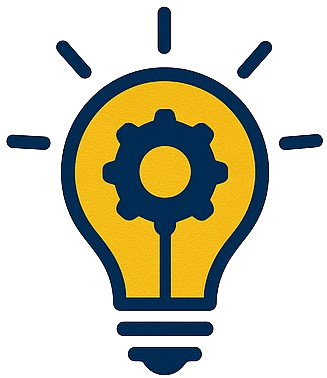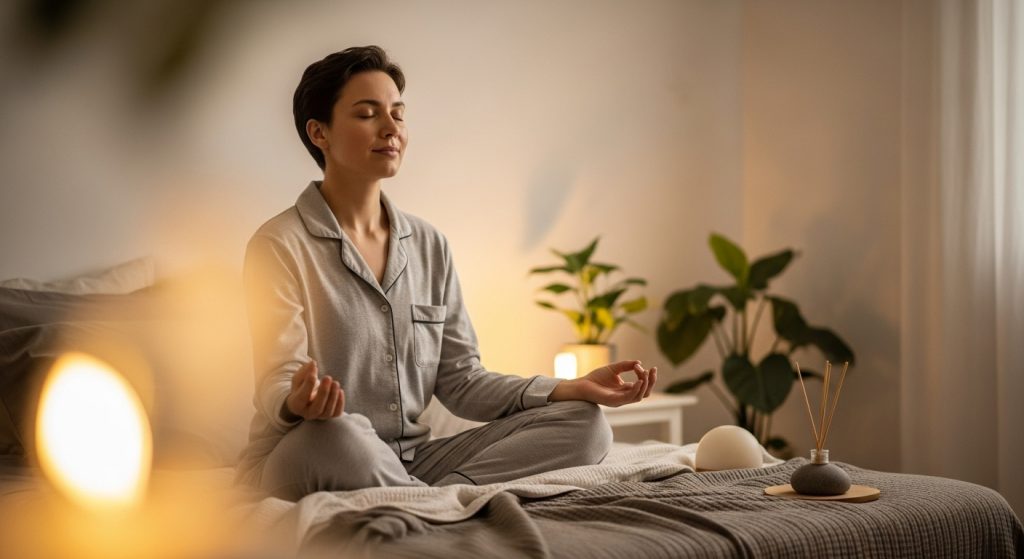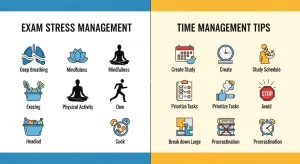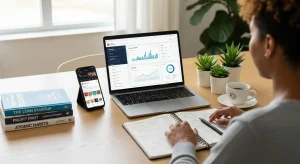Quality sleep has become one of the most sought-after wellness goals in 2025, with millions searching for effective sleep improvement strategies to combat rising insomnia and stress levels. This comprehensive guide explores evidence-based relaxation techniques, proven sleep hygiene practices, and innovative approaches that transform your nightly rest from frustrating to restorative.
Healthy Eating & Nutrition: Your Complete Guide to Wellness
Understanding Sleep Improvement: The Foundation of Wellness
Sleep improvement isn’t just about getting more hours in bed – it’s about enhancing sleep quality through strategic relaxation techniques and lifestyle modifications. While desire for better sleep is increasing, sleep satisfaction is yet to keep up, making it crucial to understand the science behind restorative rest.
Quality sleep affects every aspect of your health:
- Cognitive function – Memory consolidation and mental clarity
- Emotional regulation – Mood stability and stress resilience
- Physical recovery – Muscle repair and immune system strengthening
- Metabolic health – Weight management and hormone balance
- Longevity – Cellular regeneration and aging processes
The key to sleep improvement lies in combining proper sleep hygiene with effective relaxation techniques that calm both mind and body before bedtime.
Mindfulness & Mental Health: The Complete Guide to Inner Peace
Essential Relaxation Techniques for Better Sleep
Relaxation techniques such as meditation, breathing exercises, progressive muscle relaxation, and biofeedback can be practiced along with other aspects of sleep hygiene, creating a powerful foundation for improved sleep quality.
Progressive Muscle Relaxation for Sleep
Progressive muscle relaxation, also called Jacobson’s or deep muscle relaxation: This technique involves tensing groups of muscles all over the body one by one, and then consciously relaxing them again. This method effectively reduces physical tension that prevents deep sleep.
Step-by-Step Progressive Muscle Relaxation:
- Start with your toes – Tense for 5 seconds, then release completely
- Move to your calves – Contract muscles, then let go of all tension
- Progress through thighs – Squeeze tight, then experience the relaxation
- Continue up your body – Abdomen, chest, arms, shoulders, and face
- End with full-body awareness – Notice the contrast between tension and relaxation
Breathing Exercises for Sleep Improvement
Taking slow, deep breaths is one of the easiest and most basic ways to engage your body’s natural relaxation response. Taking 10 deep breaths alone can begin to slow your breath and create a sense of calm.
4-7-8 Breathing Technique:
- Inhale through your nose for 4 counts
- Hold your breath for 7 counts
- Exhale completely through your mouth for 8 counts
- Repeat 3-4 cycles to activate parasympathetic nervous system
Box Breathing for Sleep:
- Inhale for 4 counts
- Hold for 4 counts
- Exhale for 4 counts
- Hold empty for 4 counts
- Continue for 5-10 minutes before bed
Mindfulness Meditation for Sleep Quality
Mindfulness meditation is just one of a smorgasbord of techniques that evoke the relaxation response, according to Harvard research. Research has shown that meditation may calm the mind and promote better quality sleep. Sleep meditation techniques include guided meditation, mindfulness meditation, and body scan meditation.
Body Scan Meditation Process:
- Lie comfortably in bed with eyes closed
- Focus attention on the top of your head
- Slowly move awareness down through your body
- Notice sensations without trying to change them
- Continue from head to toes over 15-20 minutes
Ultimate Guide to Home Workout Routines: Build Strength at Home
Sleep Hygiene: Building Better Sleep Habits
Sleep hygiene forms the foundation of consistent sleep improvement, creating optimal conditions for natural relaxation and restorative rest.
Optimizing Your Sleep Environment
Temperature Control:
- Maintain bedroom temperature between 60-67°F (15.6-19.4°C)
- Use breathable bedding materials like cotton or bamboo
- Consider cooling mattress toppers for hot sleepers
Light Management:
- Install blackout curtains or eye masks
- Use dim, warm lighting 2 hours before bed
- Avoid blue light from screens after sunset
- Red light therapy continues gaining traction for boosting melatonin, calming the nervous system, and promoting restful sleep
Sound Optimization:
- Use white noise machines or earplugs
- Maintain quiet environment or consistent background sounds
- Expect hotels to push the boundaries—monetizing circadian lighting, soundproofing, air quality, smart mattresses and bespoke relaxation rituals
Mastering Virtual Interviews: Tech and Etiquette Tips
Creating a Bedtime Routine for Sleep Improvement
Read for pleasure in soft light. Take a warm bath. Do some easy stretches, progressive muscle relaxation, or deep breathing. Your actions during the day can affect your sleep that night.
90-Minute Wind-Down Routine:
| Time Before Bed | Activity | Sleep Benefit |
|---|---|---|
| 90 minutes | Dim lights, stop work | Triggers melatonin production |
| 60 minutes | Warm bath or shower | Lowers core body temperature |
| 45 minutes | Gentle stretching or yoga | Releases physical tension |
| 30 minutes | Reading or journaling | Calms racing thoughts |
| 15 minutes | Relaxation techniques | Activates sleep response |
Natural Sleep Aids and Relaxation Methods
Beyond behavioral techniques, several natural approaches support sleep improvement without dependency risks associated with pharmaceutical sleep aids.
Herbal Remedies for Better Sleep
Evidence-Based Herbal Options:
- Chamomile – Contains apigenin, which binds to brain receptors promoting sleepiness
- Valerian Root – Increases GABA levels for natural sedative effects
- Passionflower – Reduces anxiety and promotes calm mental state
- Lemon Balm – Mild sedative properties supporting relaxation
- Lavender – Aromatherapy benefits for stress reduction and sleep quality
Lifestyle Factors Supporting Sleep Improvement
Exercise Timing for Better Sleep:
- Complete vigorous exercise at least 3 hours before bedtime
- Gentle yoga or stretching can be beneficial close to sleep
- Regular daily exercise improves overall sleep quality
- Morning sunlight exposure regulates circadian rhythms
Nutrition and Sleep Quality: A good diet and regular physical exercise can help us to relax and get better sleep. And the opposite is also true: an unhealthy diet and lack of exercise can stop us from sleeping well. Avoid eating large meals close to bedtime.
Sleep-Supporting Foods:
- Tart cherries – Natural source of melatonin
- Almonds – Magnesium content promotes muscle relaxation
- Turkey – Tryptophan amino acid aids sleep hormone production
- Kiwi fruit – Contains serotonin and antioxidants supporting sleep
Simple Office Desk Stretches to Stay Active at Work
Advanced Sleep Improvement Strategies
For those experiencing chronic sleep issues, advanced techniques and technologies offer additional support for achieving restorative rest.
Technology-Assisted Sleep Improvement
Revolutionary advancements in sleep technology for 2025 are reshaping how we rest, offering more innovative, personalized solutions to improve sleep quality.
Emerging Sleep Technologies:
- Sleep tracking wearables – Monitor sleep stages and provide insights
- Smart mattresses – Adjust temperature and firmness automatically
- Circadian lighting systems – Mimic natural light patterns
- White noise apps – Customizable soundscapes for better sleep
- Temperature-regulating bedding – Maintains optimal sleep climate
Cognitive Behavioral Therapy for Insomnia (CBT-I)
CBT-I represents the gold standard for treating chronic insomnia without medication, focusing on changing thoughts and behaviors that interfere with sleep.
Core CBT-I Components:
- Sleep restriction – Limiting bed time to actual sleep duration
- Stimulus control – Creating strong bed-sleep associations
- Cognitive restructuring – Addressing anxiety-provoking thoughts about sleep
- Sleep hygiene education – Optimizing environmental and behavioral factors
- Relaxation training – Teaching effective stress management techniques
Managing Sleep Disorders and Chronic Insomnia
Don’t Toss and Turn: It helps to have a healthy mental connection between being in bed and actually being asleep. For that reason, if after 20 minutes you haven’t gotten to sleep, it’s better to get up and engage in quiet, relaxing activities until sleepiness returns.
When to Seek Professional Help:
- Persistent difficulty falling asleep for more than 3 weeks
- Frequent nighttime awakenings affecting daily function
- Excessive daytime fatigue despite adequate sleep opportunity
- Loud snoring or breathing interruptions during sleep
- Restless leg syndrome or other movement disorders
Quick Home Workout Routines for Busy Professionals
Stress Management for Better Sleep Quality
Try this plan: 1. Practice gentle breathing and progressive muscle relaxation every day (20 to 25 minutes) for two weeks, as recommended by Johns Hopkins sleep experts.
Daily Stress Reduction Techniques
Morning Stress Prevention:
- Start with 10 minutes of meditation or mindfulness
- Practice gratitude journaling to set positive tone
- Avoid checking emails/news immediately upon waking
- Engage in gentle movement or stretching
Workday Stress Management:
- Take regular breaks for deep breathing exercises
- Use progressive muscle relaxation during lunch
- Practice mindful walking between meetings
- Set boundaries around work-related communications
Evening Stress Release:
- Engage in calming activities like reading or soft music
- Practice yoga or gentle stretching routines
- Take warm baths with Epsom salts for muscle relaxation
- Write in a journal to process daily experiences
Must-Have Smartphone Features and Apps for 2025
Creating Your Personalized Sleep Improvement Plan
Successful sleep improvement requires a personalized approach that considers your unique lifestyle, challenges, and preferences.
Week 1-2: Foundation Building
Sleep Hygiene Optimization:
- Establish consistent sleep and wake times
- Create optimal bedroom environment (temperature, darkness, quiet)
- Remove electronic devices from bedroom
- Begin basic relaxation routine before bed
Week 3-4: Technique Integration
Advanced Relaxation Skills:
- Master progressive muscle relaxation technique
- Incorporate breathing exercises nightly
- Add mindfulness meditation to routine
- Track sleep patterns and quality improvements
Week 5-8: Habit Consolidation
Long-term Sustainability:
- Fine-tune personalized bedtime routine
- Address specific sleep challenges that arise
- Build resilience against sleep disruptors
- Celebrate improvements and maintain motivation
Essential Home Cybersecurity Tips for Everyone
Frequently Asked Questions
How long does it take to see improvement in sleep quality using relaxation techniques?
Most people begin experiencing sleep improvement within 1-2 weeks of consistent practice with relaxation techniques. However, significant changes in sleep quality typically occur after 4-6 weeks of regular implementation. The key factors for faster results include consistency in practicing relaxation techniques, maintaining proper sleep hygiene, and addressing underlying stress factors. Progressive muscle relaxation and breathing exercises often provide immediate benefits for falling asleep, while deeper sleep architecture improvements develop over several weeks of consistent practice.
What are the most effective relaxation techniques for people with anxiety-related insomnia?
For anxiety-related sleep disorders, the most effective relaxation techniques combine cognitive and physical approaches. Controlled breathing, mindfulness meditation, progressive muscle relaxation, and guided imagery are examples of relaxation methods that can help ease you into sleep. The 4-7-8 breathing technique is particularly effective for calming racing thoughts, while progressive muscle relaxation addresses physical tension from anxiety. Body scan meditation helps redirect attention away from worrying thoughts, and guided imagery provides positive mental focus that supports sleep improvement.
Can relaxation techniques replace sleep medication for chronic insomnia?
While relaxation techniques are highly effective for sleep improvement, they should complement rather than immediately replace prescribed sleep medications without medical supervision. Many people successfully reduce or eliminate sleep medication dependence by gradually incorporating relaxation techniques, proper sleep hygiene, and cognitive behavioral therapy approaches. The process typically requires several months of consistent practice and should be done in consultation with healthcare providers. Research shows that combining relaxation techniques with professional guidance often provides more sustainable long-term sleep improvement than medication alone.
Biohacking and Supplements for Peak Performance
Transform Your Sleep Quality Starting Tonight
Quality sleep improvement is within your reach through proven relaxation techniques, proper sleep hygiene, and consistent practice. The strategies outlined in this guide provide a comprehensive approach to achieving the restorative rest your body and mind need for optimal health and wellbeing.
Take your sleep improvement journey to the next level with professional resources and premium tools designed to accelerate your progress toward better rest.
Here are 5 Amazon affiliate products perfect for sleep improvement and relaxation:
- Weighted Blanket (15-20 lbs)
- Essential Oil Diffuser with Lavender Sleep Blend
- White Noise Machine/Sleep Sound Machine
- Memory Foam Pillow with Cooling Gel
- Blue Light Blocking Glasses
to access guided sleep meditations, relaxation technique training, and personalized sleep improvement programs that make achieving quality sleep effortless and sustainable.
Remember: every night you invest in proper relaxation and sleep hygiene is an investment in your overall health, productivity, and happiness. Your well-rested future self will thank you for taking action today.











